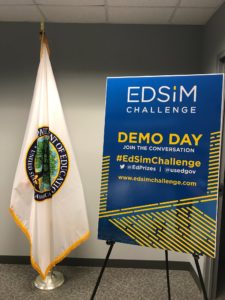Our five finalists are hard at work in the Virtual Accelerator, where they’re focused on further developing their solutions for Demo Day. An integral part of this phase is the opportunity for finalists to receive individualized advice from industry-leading mentors. The Challenge mentors represent an impressive spectrum of expertise, from instructional design to software architecture to VR game design. We’d like to thank each for their contribution to the Challenge.

Robert Bourgeois: Expert in using VR in the CTE classroom
Robert has been a middle school and high school Career & Technical Education (CTE) teacher in Durham, NC since 2003. He has instructed high school students in the use of various applications including the Adobe CS Suite, 3ds Max, and the Unity game engine. During the 2016 -17 school year, he taught and managed a small team of CTE Advanced Studies students who modeled an abandoned prison in rural Laurinburg, NC and created a virtual reality walkthrough of the site for real-world clients.

Dicxiana Carbonell: Expert in the development of CTE instruction
Dicxiana is the Assistant Superintendent of the Essex County Vocational Technical Schools. Throughout her tenure in education, she has focused on integrating innovative technologies into the instructional process. Through the GenCyber grant, awarded by the NSA, she exposed over 400 students to cyber security, and used this foundational knowledge as an introduction to computer science, web design, gaming, engineering, and cyber forensics.

Tyler Hopf: Expert in UX/UI design and 3D modeling
Tyler is a Creative Director at IrisVR where he helps professionals visualize, share, and create 3D models using virtual reality. He is also a teacher of Immersive and Virtual Reality Design at the School of Visual Arts. His expertise lies in UX/UI design and 3D modeling, along with a working knowledge of Unity.

Dalton Grey: Expert in iterative design and learning games
Dalton is a Game Designer at Institute of Play, whose aim is to transform education through play. He was the founder of State of Play NY, a R&D design studio focused on iterative design. His specialties include learning games design, iterative design, and paper prototyping with a focus on designing for constraints in education.

Dario Laverde: Expert in software architecture
Dario is a senior developer evangelist at HTC with an engineering background and over 25 years of software development experience. He has worked as an instructor, consultant, software architect, author, entrepreneur, and mentor. Dario founded several developer communities including NYC Java, NYC-GDG, NY Android, and is currently active within the VR community.

Leah Potter: Expert in instructional design
Leah has focused her career on instructional design, and has developed expertise in middle and high school curriculum development, game-based learning, digital badges, and academic and CTE standards alignment. Leah was the winner of the U.S. Department of Education’s Reach Higher Career App Challenge for her solution Hats & Ladders, a career learning platform.













